The cost of traveling Europe: real budget numbers from 9+ years of travel
What is the real cost of traveling Europe?
How do you afford to do it full-time?
How much do I need to save if I want to travel in Europe for a year (or two years or a month or six months)?
As someone who has been traveling full time for nearly nine years, most of that time in Europe, these are probably the questions I get most often about my lifestyle.
Money, unsurprisingly, is the biggest obstacle people think they’ll face on the road. Because if vacations are so pricey, wouldn’t full-time travel be even more so?
(Psst. Here’s a full breakdown of why it’s not.)
This is why for the last 10+ years, while I’ve been traveling full-time, I’ve kept track of my budgets all over the world. Because the truth is that full-time travel can be expensive (just like staying put can be expensive), but it doesn’t have to be. And the only way I know to prove it is to share my own real budgets.
Today, I’m back to share more budget updates with you. More insights into how I travel full-time and what it costs to live and travel in Europe.
First, though, let’s talk about travel styles…
 Luna sporting bedhead in Gozo, Malta.
Luna sporting bedhead in Gozo, Malta.
What full-time travel looks like for me
First, it’s important to say that there’s no right or wrong way to travel full time. There’s no standard. Every person I know who does it does it differently.
I have friends who circle back to their favorite places every single year. I have friends who are always chasing new adventures. I’ve met digital nomads who live out of hostels and move every few days and nomads who spend a year or more in one place.
So, before I dive into how I travel, I’ll caveat it by saying that my way is not the way. There are people who travel on a much lower budget than mine and people who travel on a higher budget than mine. There are people who travel faster and people who travel slower. This budget breakdown is based on my experiences and my experiences alone.
Okay, so what are my experiences?
 A moody Gozo landscape.
A moody Gozo landscape.
For the first few years, I traveled solo with my dog. For five years, I traveled as part of a couple (though my budgets here on the blog reflect my half of shared expenses + 100% of my personal expenses). And now I’m back to solo-girl-with-dog-takes-on-the-world. (Here’s a comparison of costs solo vs. traveling with someone else.)
I mostly travel around Europe, though I’ve also done a bit of North and South America in the past few years (and before I hit the road full-time, I visited every continent except Antarctica).
I prefer to stay in one place for at least a month (and sometimes two or three) and I tend to rent comfortable apartments in local neighborhoods. If I’m staying in a hotel or hostel, it’s usually only for a weekend trip or a travel day.
I’m a foodie through and through, so I devote a large portion of my budget to good, fresh, usually organic food and I eat out pretty regularly, especially if I’m in a place known for its cuisine.
I work part-time (on writing books, content strategy and copywriting). This means big chunks of my week are devoted to work, so someone retired or vacationing is likely to spend quite a bit more than I do.
And in my spare time, I love to cycle, hike, read, explore, and eat, most of which is cheap or free and keeps entertainment budgets on the low side. I rarely do museums or indoor attractions.

Sheep fleeing the scene on a long hike in the Swiss Alps.
The cost of traveling Europe: monthly expense breakdown
Before we get into individual budgets around the world, here’s a breakdown of my general monthly expenses and how I approach them:
Housing: This was my biggest expense in the US, and it’s my biggest expense now. From 2012 to 2015, when I was traveling solo, I spent about $1,000 per month. In 2015 to 2021, my partner and I split the rent, so we could afford a nicer space and usually keep our individual spending on the lower side. I shot for under $800 per person per month and we often came in under $600 each. Now, solo again and with accommodation prices having risen over the years, I’m upping my housing budget to $1,500. I’ll still try to come in under when I can, but that’s my new ceiling.
So, what’s the secret to affordable accommodations while traveling in Europe? Traveling slow. Monthly rental costs are significantly lower than nightly or weekly rentals. On sites like Flatio and Airbnb, monthly discounts run anywhere from 20% – 70%.
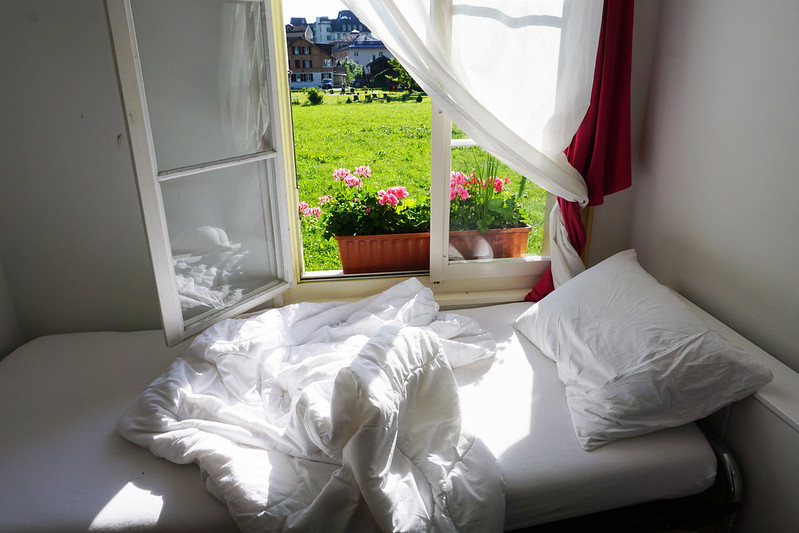 My summer room in a Swiss farmhouse.
My summer room in a Swiss farmhouse.
Food: Perhaps unsurprisingly, this foodie’s second highest expense is meals. I track my spending on groceries separately from my spending on eating out. I don’t put a budget ceiling on groceries because eating fresh, high-quality food is really important to me and I’d rather spend a bit more on groceries (and a bit less on other things) than take shortcuts with my health or joy.
In the states, I shopped at organic grocery stores and tried to buy healthier options, which were often a bit pricier. In Europe, I shop at fresh markets, local butchers, and tiny bakeries most of the time and stay away from imports that might have questionable chemicals or ingredients.
I always strive to only buy what I need and to buy it in the best quality, most local form I can. I mostly cook at home instead of eating out and when I do eat out I go for quality over quantity.
Recent grocery budgets have run about $393 (Zagreb, Croatia), $614 (Thun, Switzerland), $653 (Bad Ischl, Austria), and $429 (Tartu, Estonia). Eating out budgets in those same locations were around $257 (Zagreb), $0 (Thun), $41 (Bad Ischl), and $88 (Tartu). This means totals for those three places landed at $650 (Zagreb), $614 (Thun), $694 (Bad Ischl), and $517 (Tartu). As you can see, food spending varies, but not enormously. If you read my older budgets, you’ll also notice that the average has gone up over time (which makes sense, because inflation).
 Bull-heart tomato, Switzerland.
Bull-heart tomato, Switzerland.
Transportation: Since I tend to stay longer in one place, transportation costs generally run pretty reasonable (e.g. far less than I spent when I owned a car). Every month or two, I buy a long-distance train ticket or two, and maybe once or twice a year I take a flight (though I try to fly as little as possible both because I hate flying and I try to be conscious of my environmental footprint).
In between big train journeys, I choose to walk whenever possible (which, in Europe, is nearly always) and only take buses and metros when the weather is walking-prohibitive, if the walk would be more than an hour long, if I’m carrying something heavy, or if I’m in a particularly busy city and the walk would be crowded or stressful.
These days, I spend anywhere from about $25 (Prague unlimited monthly transit pass) on a month where I’m staying put to $300ish (trains from Rennes, France, to Prague, Czech Republic) on a month when I’m moving from one base to another.
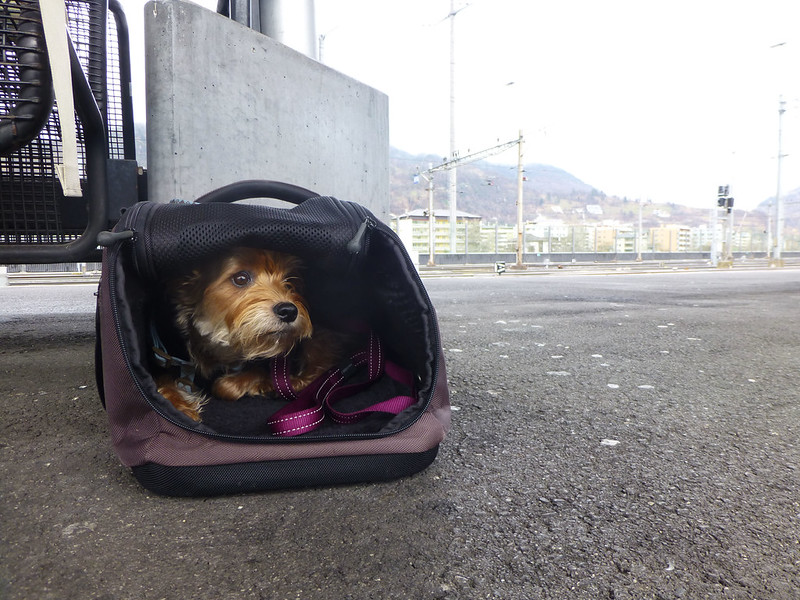
Waiting for the train.
Luna the traveling pooch’s food and care: This varies a little from country to country, but rarely exceeds $200 per month. Luna eats a homemade diet primarily consisting of rabbit, fish, quinoa, and veggies (the diet was created with a veterinary nutritionist and if you decide to do the same, I highly recommend hiring one through your vet), and I’m not very strict about separating her food budget from mine, so expect that some of the grocery budget is actually going to Luna.
As with human health care, I’ve found vet care to be significantly more affordable in Europe (compared to the US). In Latvia, four injections, a blood test, two weeks of pancreatic enzyme pills, a vet consult, and an exam cost just over $100. In Dubrovnik, Croatia, in a similar vet emergency, the bill for the sedation, IV fluids, blood work, x-ray, exam, anti-nausea shot, and 100 days worth of pancreas pills was about $150. In the US, the cost would have been at least tripled in each of those cases. A single blood test in Colorado cost us upwards of $200 last time we were there.
Entertainment/fun money: When I’m traveling, most of my activities are free or cheap, so this line item is always pretty small compared to the others.
Supplies: These tend to run less abroad as well, in part because I am careful about what I buy, since I carry everything on my back, and, in part because I’m less bored and thus feel less of a need to shop. The ironic and wonderful thing about this is that the things I buy are often higher quality and more expensive, yet I generally spend less overall than I did in the states.
 Lunch in Rome!
Lunch in Rome!
Health insurance and healthcare: Since I’m currently based in Portugal, I’m relying on the local health system. While traveling more extensively, I previously paid $268 per month for GeoBlue insurance that covered me anywhere in the world except the US. Before that, I tried travel insurance through World Nomads, which I found wildly frustrating (despite marketing themselves to travelers, they require you to jump through a LOT of paperwork hoops that require access to printers, scanners, and copy machines) and IMG Global, who ignored my emails and took months upon months to even acknowledge my claims after I was hospitalized on Malta. I would not recommend either company.
For anyone who’s used a healthcare system abroad, it’ll come as no surprise that pretty much everywhere in cheaper than the US. Pre-Obamacare, I paid $150 for three months of birth control pills in the US. A three-month supply (and a doctor visit to get the prescription) in Germany cost me under $100. In Switzerland, that number dropped to around $50. And in Vietnam, the same pills (same ingredients, different brand name) were $10 and available over the counter.
In all, I try to keep monthly spending under $2,500 (not including my business spending). And even with this as my budget ceiling, I often come in under. A few months ago, I did the math on the 30+ real Europe travel budgets linked below (scroll down for links) and the monthly average came in at $1,637.
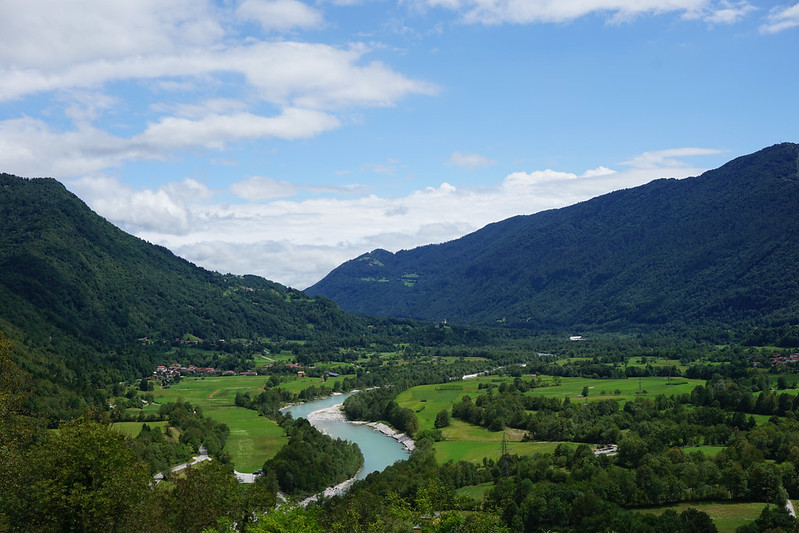 Soca Valley, Slovenia.
Soca Valley, Slovenia.
For those who’d like a more detailed look at my monthly budgets around the world, here they all are categorized by price range (click on the links for in-depth details on the budgets):
My real monthly budgets
From cheapest to most expensive monthly budget. Click on each location for a more detailed breakdown.
Non-European locations are marked with an *. My favorite places appear in bold. Cost is in parentheses. And I’ve indicated the year the budget is from (obviously account for some inflation when using budgets from 10 years ago) and whether the budget was solo travel or traveling with a partner/friend (partnered travel typically means lower housing costs).
Under $1350 per month:
Konjic, Bosnia and Herzegovina / one month ($1157)
2017 / partnered
Labin, Croatia / one month ($1175)
2021 / solo
Tartu, Estonia / one month ($1213)
2020 / partnered
Tulum, Mexico / one month ($1232)*
2018 / partnered
Kotor, Montenegro / one month ($1253)
2019 / partnered
Mostar, Bosnia and Herzegovina / one month ($1296)
2017 / partnered
Sayulita, Mexico / one month ($1301)*
2013 / solo
Riga, Latvia / one month ($1313)
2019 / partnered
Split, Croatia / one month ($1317 & $1241)
2019 & 2013 / partnered & solo
Zagreb, Croatia / one month ($1337)
2018 / solo
Playa del Carmen, Mexico / one month ($1350)*
2013 / solo

The trail to Unspunnen Castle, Wilderswil, Switzerland
Under $1,500 per month:
Taormina, Italy / one month ($1364)
2017 / partnered
Porto, Portugal / one month ($1366)
2022 / solo, living full-time here
Kranjska Gora, Slovenia / one month ($1385)
2017 / partnered
Toledo, Spain / one month ($1388)
2015 / solo
Kobarid, Slovenia / one month ($1422)
2015 / solo
Brasov, Romania / one month ($1433)
2018 / partnered
Dubrovnik, Croatia / one month ($1443)
2017 / partnered
Tallinn, Estonia / one month ($1460)
2019 / partnered
 Hiking Kobarid, Slovenia.
Hiking Kobarid, Slovenia.
Under $1,700 per month:
Interlaken, Switzerland / one month ($1558)
2019 / partnered
Ljubljana, Slovenia / two weeks ($808)
2015 / solo
Bad Ischl, Austria / one month ($1618)
2020 / partnered
Rennes, France / one month ($1648)
2018 / partnered
Nerja, Spain / one month ($1689)
2015 / solo
Edinburgh, Scotland / one month ($1697)
2012 / solo

Having a moment in Bled, Slovenia.
Under $1,800 per month:
Ljubljana, Slovenia / second stay, one month ($1735)
2017 / partnered
Grenoble, France / one month ($1739)
2018 / partnered
Prague, Czechia / one month ($1752)
2018 / partnered

Bergamo, Italy
Under $2,000 per month:
Perugia, Italy / one month ($1882)
2013 / solo
Flagstaff, Arizona / one month ($1893)*
2016 / solo
Rome, Italy / one month ($1911)
2017 / partnered
Chamonix, France / two weeks ($962)
2015 / solo
Vancouver, Canada / one month ($1988)*
2016 / partnered
Over $2,000 per month:
Lauterbrunnen, Switzerland / three monthly budgets compared (varies)
2015 (and before) / solo
Amsterdam, Netherlands / two weeks ($1008)
2015 / partnered
Biarritz, France / one month ($2029)
2014 / solo
Innsbruck, Austria / one week ($511)
2018 / solo
Paris, France / one month ($2118)
2013 / solo
Thun, Switzerland / one month ($2124)
2021 / partnered
New York, New York, USA / one month ($2297)*
2018 / partnered
Zagreb, Croatia / one month splurge! ($2320)
2021 / solo
Opatija, Croatia / one month splurge! ($2897)
2021 / solo(ish)
Cycling across France / one month ($3091)
2015 / solo
 Day one: cycling across France.
Day one: cycling across France.
My budgets for shorter trips
Now, what about short trips? Weekends, overnights, week-long vacations? I’ve got some real budgets on those too, though they’re fewer and farther between for me. Here are they, from cheapest to most expensive per-day:
Vrbovsko, Croatia / 3 days ($87 / $29 per day)
2021 / solo
Plitvice Lakes National Park, Croatia / 3 days ($184 / $62 per day)
2021 / solo
Denver to LA road trip / 2 days ($207 / $103 per day)*
2012 / solo
Tbilisi, Georgia / 10 days ($1050 / $105 per day)*
2019 / partnered
Colmar, France / 5 days ($539 / $108 per day)
2019 / partnered
Paris, France / 5 days ($663 / $133 per day)
2019 / partnered
Emilia Romagna, Italy / 5 days ($776 / $155 per day)
2014 / solo

Business costs
It’s worth noting that you won’t see any business costs in the above budgets. My business expenses vary greatly based on what I’m working on, how much active marketing/sales I’m doing, and what kind of side projects (blogs, self-published books, etc.) I’m taking on.
The few consistent things I pay for business-wise include:
Subscriptions for Microsoft Word, Adobe Photoshop, cloud storage, and a media subscription or two.
I now own a cell phone (turns out living full-time in Portugal requires one), but I also need a US number, so I use TextNow on my iPad for US calls/client calls. The basic number is free (because they serve up ads), but I pay a small fee in order to get a few extra benefits.
Business insurance, which runs me about $50 per month, and a yearly fee (about $100) for my registered agent to handle my LLC renewal and receive any business mail for me.
Once a year or once every few years, I also have expenses for web hosting and domain renewal for the website. This usually costs me less than $100 per year.
 Luna breaks in our workspace in Flagstaff, Arizona.
Luna breaks in our workspace in Flagstaff, Arizona.
Taxes: Finally, a note on the most unavoidable of all expenses – taxes. In general (though not in every case), you are expected to pay taxes in the place you reside. If you live in the US, you pay in the US. If you live in Switzerland, you pay in Switzerland.
If you’re from the US, you’ll always have to file US taxes even if you’re a resident abroad, but you may be eligible for the FEIE, which is basically there to prevent you from paying double taxes. (Rather than get into it further here, I’ll suggest you book a consult with a US tax accountant. Many do free first consults and they will know so much more than I do about all the ins and outs of your particular situation.)
NOTE: If you’re paying in the states and self-employed, taxes are due quarterly, not yearly. This means when I’m paying in the States, I sit down every quarter and calculate the taxes I owe and send the government a check. At the end of the year, I hire a tax whiz (which generally runs me another $350 – $500) to help me make sure everything has been paid and filed properly.
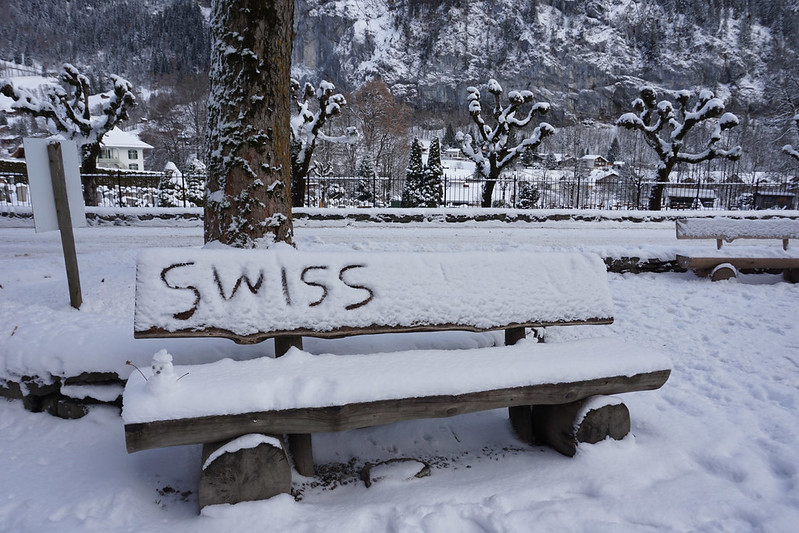
Air travel expenses (& other big one-time costs)
There are a few things I don’t budget for monthly (or include in my monthly budget posts) because they are yearly or quarterly expenses and may vary greatly from month to month. One of these things is plane tickets.
I’m not a traveler who flies a lot, preferring to explore one continent thoroughly at a time and take trains where possible both because it’s simply a more pleasant way to travel, because it’s more environmentally responsible, and because the older I get the worse my motion-sickness gets, so flying has stopped being even a little bit fun.
So, since I’m not buying them monthly or even bi-monthly, I usually don’t track plane ticket costs monthly and instead factor them into my budget on a quarterly or yearly basis.
In 2021, I took four flights (one-way Switzerland to Croatia, one-way Croatia to Portugal, then round-trip Portugal – Croatia to collect my visa). In 2022, I only took one (one-way from Paris to Porto – I took trains in the other direction).
Replacing technology (my laptop or tablet), big one-time medical expenses, and other large one-time purchases (like my folding bike) are also something I look at quarterly or annually rather than monthly.

Thun, Switzerland
Saving money while traveling full-time
Finally, for me, part of feeling comfortable starting my business and then, a year or so later, leaving to travel full-time was having a decent financial buffer in the bank. I was advised while starting my business to have at least six months worth of expenses in the bank just in case. Being a bit neurotic about money, I waited until I had 10 months and enough clients that I was already almost breaking even.
Similarly, when I started traveling, even though I would be working normally and hopefully earning normally, part of feeling comfortable was the knowledge that I had a buffer. If all my clients ditched me in month one, I could live for a year without income (assuming I lived relatively frugally).
 Luna living large.
Luna living large.
Everyone operates differently on this. When my aunt started her business, she quickly went into debt. Yet she was wildly successful over time. I’ve also heard stories of those who moved to a cheap part of Asia to start their business, which meant the limited funds they had could last them much longer while they got things off the ground. I know one man who told me it’s going to take $150,000 to start his business. Another woman told me a success story that started with just 3,000 euros in the bank. An old roommate told me she’s been traveling and working for years with just a few hundred euros to her name.
My income is variable, but I also try to set aside a decent percentage each month for the future–both to tackle unexpected expenses or emergencies, to be prepared for my yearly tax bills, and, of course, to create more security for myself in case I ever cannot or no longer want to work.
 Pizza in Naples.
Pizza in Naples.
Any expenses you tend to have during travel that I haven’t mentioned? Any questions about travel expenses and budgeting? Toss them in the comments.
Comments
-
-
Sarah F Gilmore
Idnloke to know more about working abroad
-
-
Naomi
I’m not brave enough to try this with my husband and two kids, but I loved reading about how you do it! Kudos!!
-
Frans
Thanks for sharing your experience! This gives us an idea of how to budget for travel in Europe.
-
Val
I am really enjoying following your adventures. I am waiting for a Portuguese residency permit and will be dipping my toe in the nomadic water soon. One question I am grappling with – what do you do for health insurance when you are back in the US?
-
Davina van Buren
Amazing post!! Thanks for the detailed breakdowns. So happy to have found your site – it’s SO helpful and informative for slow travelers.
-
Jade DeCosta
Great post! Thanks for sharing these insights with everyone. I wonder if you might answer a tax question. If one were to travel 1-3 months in each country, does that mean you need to file taxes in each of those countries plus the US?? I get if one were in the same country for over 6mo then that country would probably be considered the country of residence for tax filing purposes but what about when hoping county to county, never staying in any one country longer than 3mo??
Thanks in advance for any insights on my tax question!
Jade
-
monica
i’m a new dog owner (about 9 months) and also planning for a 6-month travel sabbatical in about 1.5 years. i’m still debating whether i should take my yoshi with me (he’s a 13 lb chiwienie). I’ve never flown with him before, and I’m wondering if you have any tips and tricks to help ease him into the process? you’re an inspiration!
-
Ronald Christian
Thank you a million times over!
-
Kevin
Thanks, Gigi. I needed this. It gives me courage as a single 55 yo American dude. I need some challenge in my life…something to conquer…something that will keep me on my toes. I’ve always suffered from bouts of wanderlust and I’m just plain DONE with corporate health/academic full time work. I did a back-of-the-envelope calculation on my expenses and came out around 2,200/mo traveling mostly in European Union with time in Serbia, Montenegro, B/H, SE Asia, Georgia and Turkey to mitigate the Schengen rules. Any reason you spent so little time in the Balkans? Is it a solo-female traveler thing? Sadly Russia appears off the list. I have spent a fair amount of time there before.
I have savings and a professional license (planning to do consulting over zoom). I plan to work part time (10-12 hours/wk) while honing film photography, reading for pleasure, learning about local history, and making friends. My budget is a bit lighter for accommodations (I don’t mind living in an Airbnb room) and heavier on LOCAL travel. I want to hike and spend time shooting landscapes in the areas I choose. This is a giant question mark in my mind. How to get to these places without a vehicle? I’m a bit reticent about using a scooter and don’t want to spend a fortune on taxi. I’m thinking there might be local bus service that gets me close in many places? Any insights here would be appreciated.
Your style is very much how I view my own journey. Stay in one place 1-2 months to maximize accommodation expenditures, minimize European touristy museums (been there done that—going to 1-2 local gems is my thought), mostly eat at home, and take rail day trips once a month with a night-over. Kudos for avoiding the BIG European cities. That is exactly my plan. I don’ think you could force me to spend time in Paris for more than 3 days, mirroring my aversion to New York, Chicago and LA. Lol.
Once again, thank you for the inspiration! Hit me up on email if you like. If you have any tips on making local friends in the places you traveled, I’m all ears. Stay safe and pleasant travels!

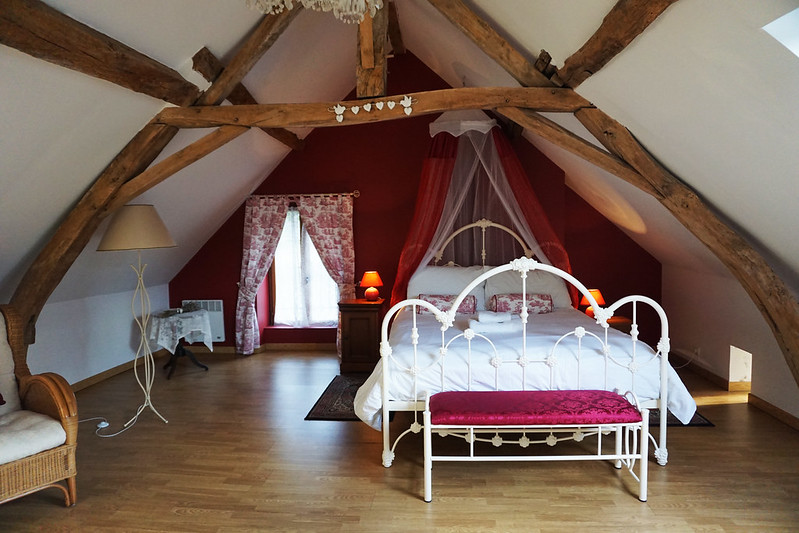
Elizabeth Roderick
This is so cool. Thank you for this.
I’m living in a tiny house on a farm right now, but after my kid graduates high school I – or perhaps both of us – have considered living like this for a while. I’m building up my author/editor business, and it certainly would be nice to get around. I get really restless staying in one spot too long.